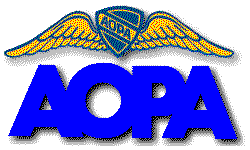Answer: FAA's New Plan Would Incur Debt; Current System
Doesn't
It's a clear-cut case of the government attempting to "fix" a
problem that isn't broken... and we've seen before how those
efforts often turn out. That's the message Phil Boyer, President of
the Aircraft Owners and Pilots Association, had for government
officials this week, during a hearing on the Bush administration's
proposed FAA funding reauthorization plan.

In Thursday's hearing before the Senate Commerce, Science and
Transportation Committee on FAA reauthorization, Boyer pointed out
the Inspector General of the US Department of Transportation says
as long as Congress continues to pay for part of the FAA out of
general tax funds, the current system can fully fund modernization
efforts.
Furthermore, according to AOPA the managing director of physical
infrastructure for the Government Accountability
Office says the proposed funding plan, which also
calls for general tax fund contributions, can't fund NextGen
without incurring debt.
Boyer's message came down to one simple point: the current
system of funding the Federal Aviation Administration works. The
proposed system doesn't... and the government itself says so. "So
which funding system is 'broken?'" Boyer asked.
FAA Administrator Marion Blakey has spent the last two years
pushing for a radical change in how the agency is funded, claiming
that the current system is broken and unable to pay for the
modernization of the air traffic system that everyone in aviation
agrees is necessary.
"We now know the Bush Administration's proposal is to increase
taxes on general aviation and impose user fees on every segment of
aviation," said Boyer. "Airlines will pay fees to talk to air
traffic control; general aviation will pay to access 'congested
airspace;' airframe manufacturers will pay higher fees to certify
their aircraft; and pilots will pay much more for medical and pilot
certificates.
"And still, the proposed scheme falls hundreds of millions of
dollars short of what the current system would raise each
year."
 AOPA conducted detailed
financial analysis of the FAA's current funding structure, using
figures from the Administration's Office of Management and Budget
and assuming a 21.5 percent contribution from general tax revenues
-- in line with historical levels and just two-and-a-half percent
more than the FAA's assumption.
AOPA conducted detailed
financial analysis of the FAA's current funding structure, using
figures from the Administration's Office of Management and Budget
and assuming a 21.5 percent contribution from general tax revenues
-- in line with historical levels and just two-and-a-half percent
more than the FAA's assumption.
The result? The analysis determined the current system could
provide some $20 billion over the next five years to pay for the
Next Generation Air Traffic System, as the modernization project is
known.
"Once again, AOPA's analysis has been verified by the federal
government," said Boyer. "This is just more proof that the way we
pay for the safest, most efficient air transportation system in the
world works. There is no need to shift to a system that starts us
down the road toward privatizing an inherently governmental
function."
Sadly, common sense and logic hasn't always stopped the
government from "improving" things before...
 NTSB Final Report: Cessna 177B
NTSB Final Report: Cessna 177B ANN's Daily Aero-Term (05.08.25): Final Approach Fix
ANN's Daily Aero-Term (05.08.25): Final Approach Fix Aero-News: Quote of the Day (05.08.25)
Aero-News: Quote of the Day (05.08.25) ANN's Daily Aero-Term (05.09.25): Estimated (EST)
ANN's Daily Aero-Term (05.09.25): Estimated (EST) ANN's Daily Aero-Linx (05.09.25)
ANN's Daily Aero-Linx (05.09.25)




